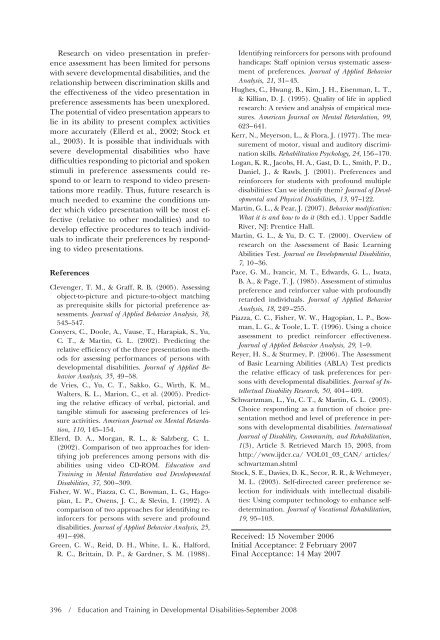Download This Article (PDF) - Division on Autism and ...
Download This Article (PDF) - Division on Autism and ...
Download This Article (PDF) - Division on Autism and ...
Create successful ePaper yourself
Turn your PDF publications into a flip-book with our unique Google optimized e-Paper software.
Research <strong>on</strong> video presentati<strong>on</strong> in preference<br />
assessment has been limited for pers<strong>on</strong>s<br />
with severe developmental disabilities, <strong>and</strong> the<br />
relati<strong>on</strong>ship between discriminati<strong>on</strong> skills <strong>and</strong><br />
the effectiveness of the video presentati<strong>on</strong> in<br />
preference assessments has been unexplored.<br />
The potential of video presentati<strong>on</strong> appears to<br />
lie in its ability to present complex activities<br />
more accurately (Ellerd et al., 2002; Stock et<br />
al., 2003). It is possible that individuals with<br />
severe developmental disabilities who have<br />
difficulties resp<strong>on</strong>ding to pictorial <strong>and</strong> spoken<br />
stimuli in preference assessments could resp<strong>on</strong>d<br />
to or learn to resp<strong>on</strong>d to video presentati<strong>on</strong>s<br />
more readily. Thus, future research is<br />
much needed to examine the c<strong>on</strong>diti<strong>on</strong>s under<br />
which video presentati<strong>on</strong> will be most effective<br />
(relative to other modalities) <strong>and</strong> to<br />
develop effective procedures to teach individuals<br />
to indicate their preferences by resp<strong>on</strong>ding<br />
to video presentati<strong>on</strong>s.<br />
References<br />
Clevenger, T. M., & Graff, R. B. (2005). Assessing<br />
object-to-picture <strong>and</strong> picture-to-object matching<br />
as prerequisite skills for pictorial preference assessments.<br />
Journal of Applied Behavior Analysis, 38,<br />
543–547.<br />
C<strong>on</strong>yers, C., Doole, A., Vause, T., Harapiak, S., Yu,<br />
C. T., & Martin, G. L. (2002). Predicting the<br />
relative efficiency of the three presentati<strong>on</strong> methods<br />
for assessing performances of pers<strong>on</strong>s with<br />
developmental disabilities. Journal of Applied Behavior<br />
Analysis, 35, 49–58.<br />
de Vries, C., Yu, C. T., Sakko, G., Wirth, K. M.,<br />
Walters, K. L., Mari<strong>on</strong>, C., et al. (2005). Predicting<br />
the relative efficacy of verbal, pictorial, <strong>and</strong><br />
tangible stimuli for assessing preferences of leisure<br />
activities. American Journal <strong>on</strong> Mental Retardati<strong>on</strong>,<br />
110, 145–154.<br />
Ellerd, D. A., Morgan, R. L., & Salzberg, C. L.<br />
(2002). Comparis<strong>on</strong> of two approaches for identifying<br />
job preferences am<strong>on</strong>g pers<strong>on</strong>s with disabilities<br />
using video CD-ROM. Educati<strong>on</strong> <strong>and</strong><br />
Training in Mental Retardati<strong>on</strong> <strong>and</strong> Developmental<br />
Disabilities, 37, 300–309.<br />
Fisher, W. W., Piazza, C. C., Bowman, L. G., Hagopian,<br />
L. P., Owens, J. C., & Slevin, I. (1992). A<br />
comparis<strong>on</strong> of two approaches for identifying reinforcers<br />
for pers<strong>on</strong>s with severe <strong>and</strong> profound<br />
disabilities. Journal of Applied Behavior Analysis, 25,<br />
491–498.<br />
Green, C. W., Reid, D. H., White, L. K., Halford,<br />
R. C., Brittain, D. P., & Gardner, S. M. (1988).<br />
Identifying reinforcers for pers<strong>on</strong>s with profound<br />
h<strong>and</strong>icaps: Staff opini<strong>on</strong> versus systematic assessment<br />
of preferences. Journal of Applied Behavior<br />
Analysis, 21, 31–43.<br />
Hughes, C., Hwang, B., Kim, J. H., Eisenman, L. T.,<br />
& Killian, D. J. (1995). Quality of life in applied<br />
research: A review <strong>and</strong> analysis of empirical measures.<br />
American Journal <strong>on</strong> Mental Retardati<strong>on</strong>, 99,<br />
623–641.<br />
Kerr, N., Meyers<strong>on</strong>, L., & Flora, J. (1977). The measurement<br />
of motor, visual <strong>and</strong> auditory discriminati<strong>on</strong><br />
skills. Rehabilitati<strong>on</strong> Psychology, 24, 156–170.<br />
Logan, K. R., Jacobs, H. A., Gast, D. L., Smith, P. D.,<br />
Daniel, J., & Rawls, J. (2001). Preferences <strong>and</strong><br />
reinforcers for students with profound multiple<br />
disabilities: Can we identify them? Journal of Developmental<br />
<strong>and</strong> Physical Disabilities, 13, 97–122.<br />
Martin, G. L., & Pear, J. (2007). Behavior modificati<strong>on</strong>:<br />
What it is <strong>and</strong> how to do it (8th ed.). Upper Saddle<br />
River, NJ: Prentice Hall.<br />
Martin, G. L., & Yu, D. C. T. (2000). Overview of<br />
research <strong>on</strong> the Assessment of Basic Learning<br />
Abilities Test. Journal <strong>on</strong> Developmental Disabilities,<br />
7, 10–36.<br />
Pace, G. M., Ivancic, M. T., Edwards, G. L., Iwata,<br />
B. A., & Page, T. J. (1985). Assessment of stimulus<br />
preference <strong>and</strong> reinforcer value with profoundly<br />
retarded individuals. Journal of Applied Behavior<br />
Analysis, 18, 249–255.<br />
Piazza, C. C., Fisher, W. W., Hagopian, L. P., Bowman,<br />
L. G., & Toole, L. T. (1996). Using a choice<br />
assessment to predict reinforcer effectiveness.<br />
Journal of Applied Behavior Analysis, 29, 1–9.<br />
Reyer, H. S., & Sturmey, P. (2006). The Assessment<br />
of Basic Learning Abilities (ABLA) Test predicts<br />
the relative efficacy of task preferences for pers<strong>on</strong>s<br />
with developmental disabilities. Journal of Intellectual<br />
Disability Research, 50, 404–409.<br />
Schwartzman, L., Yu, C. T., & Martin, G. L. (2003).<br />
Choice resp<strong>on</strong>ding as a functi<strong>on</strong> of choice presentati<strong>on</strong><br />
method <strong>and</strong> level of preference in pers<strong>on</strong>s<br />
with developmental disabilities. Internati<strong>on</strong>al<br />
Journal of Disability, Community, <strong>and</strong> Rehabilitati<strong>on</strong>,<br />
1(3), <str<strong>on</strong>g>Article</str<strong>on</strong>g> 3. Retrieved March 15, 2003, from<br />
http://www.ijdcr.ca/ VOL01_03_CAN/ articles/<br />
schwartzman.shtml<br />
Stock, S. E., Davies, D. K., Secor, R. R., & Wehmeyer,<br />
M. L. (2003). Self-directed career preference selecti<strong>on</strong><br />
for individuals with intellectual disabilities:<br />
Using computer technology to enhance selfdeterminati<strong>on</strong>.<br />
Journal of Vocati<strong>on</strong>al Rehabilitati<strong>on</strong>,<br />
19, 95–103.<br />
Received: 15 November 2006<br />
Initial Acceptance: 2 February 2007<br />
Final Acceptance: 14 May 2007<br />
396 / Educati<strong>on</strong> <strong>and</strong> Training in Developmental Disabilities-September 2008
















